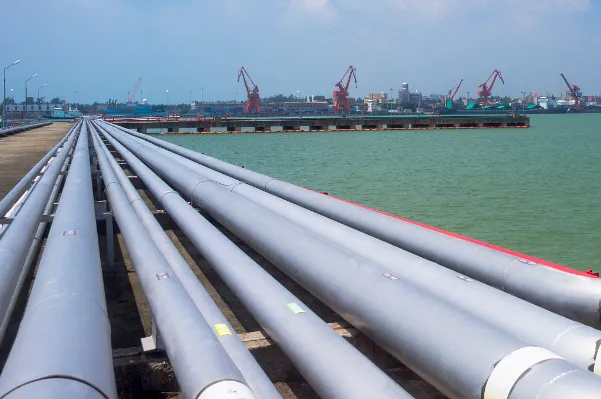What are the main goods transported by pipelines? Fluid goods such as crude oil, oil and natural gas. Pipeline transportation is a mode of transportation that uses pipelines as a means of transportation to transport liquid and gas materials over long distances.
Pipeline transportation is a special mode of freight transportation that has developed with the production and transportation of oil. Its facilities only include pipeline lines and gas pumping stations at both ends of the pipeline. Goods are transported directly in the pipeline without transportation tools such as cars and trains. In other words, pipelines are a mode of transportation that combines transportation tools and transportation routes. With pipeline transportation, goods move in the pipeline with the pressure of high-pressure air pumps to reach the destination.
At present, there are three main types of pipelines: liquid pipelines (mainly transporting oil and its products), gas pipelines (mainly transporting natural gas), and slurry pipelines (mainly transporting coal slurry). In recent years, pipelines used for fluid transportation are mainly seamless pipes, while natural gas transportation is mostly welded pipes. Transportation technology experts in many countries are committed to studying pipelines that can transport ordinary goods, but technical and cost constraints are still difficult to overcome. It is expected that in the near future, the use of pipelines to transport ordinary goods will be limited to the trial stage.
Advantages of pipeline transportation:
The advantages of pipeline transportation are large transportation volume, low freight rate, low loss, safety and reliability. The main transported goods are oil and natural gas. Compared with other modes of transportation, pipeline transportation has its own unique advantages:
(1) It is not affected by the ground climate and can operate 24 hours a day, 365 days a year.
(2) Goods do not need to be packaged.
(3) Goods move in the pipeline, and the damage rate is very low.
(4) One-way transportation, no empty return problem.
(5) Low energy consumption, small land occupation, safety, and less pollution.
(6) Relatively simple operation and management.
(7) Low unit operating cost. Pipeline operation only requires a very small number of maintenance personnel at the gas pump station, and the labor cost is very low.

Disadvantages of pipeline transportation
(1) It is limited to the transportation of liquids, gases and a few homogeneous solid goods, which is too single.
(2) Low mobility and flexibility, limited to the transportation of goods in fixed pipelines, and one-way transportation.
(3) The initial fixed investment cost of pipeline construction is high.
Pipeline transportation has distinct characteristics and a very limited scope of application, but it is very popular in the transportation of crude oil and its products, natural gas, and coal.
Types of Pipeline Systems
Pipeline systems are generally categorized into three types:
Liquid Pipelines: Primarily used for crude oil and refined petroleum.
Gas Pipelines: Used for natural gas and liquefied petroleum gas (LPG).
Slurry Pipelines: Used to transport solids suspended in liquids, such as coal or iron ore slurry.
In modern pipeline infrastructure, seamless steel pipes are widely used due to their strength and durability, while
ERW (Electric Resistance Welded) pipes are also common, particularly in natural gas distribution.






 English
English Español
Español بالعربية
بالعربية











 Phone :
Phone :  Whatsapp :
Whatsapp :  Email :
Email : 


